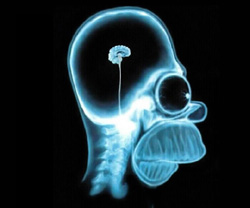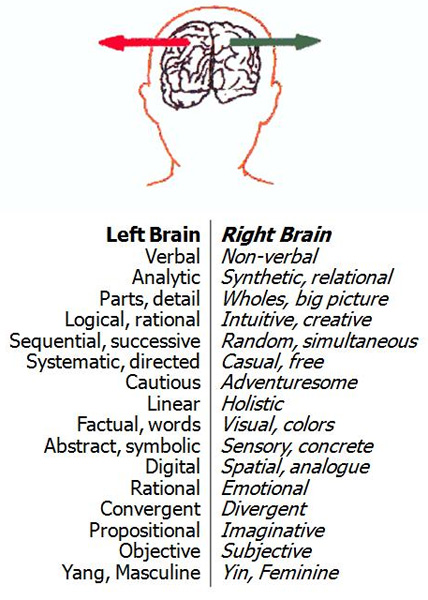Imagine you sit down to compose or mix a song. You’re in your creative zone, and you feel like nothing can break the flow. All of a sudden you come up with a brilliant musical idea, but you pause to think: “what do I need to set up to get this sound happening?” As soon as you find the right software, sounds, routing etc., your idea vanishes. Frustrating.
Right & Left Brain
I’m sure you’re aware that different parts of your brain are utilized for specific functions. I don’t know much about brain science, but have a look at the image below, which lists certain actions that are predominantly left or right brain. This is something to be aware of, especially in a field like audio engineering/production where technical, analytical, and creative skills will be simultaneously expected of you.
While in your creative flow (right brain), as soon as you stop to deal with left brain technicalities, you de-rail the freight train of your creative process. Of course sometimes you can pause, do the task and continue on, but personally, this often creates unnecessary anxiety and interrupts the creative flow. Worst case, you forget your idea completely, and lose the spark that sometimes only occurs purely in the moment.
Workflow
When recording, mixing, or composing, it may be helpful to take care of specific left brain tasks right from the start. By separating left brain tasks (technical things like naming tracks, routing, patching etc) from right brain tasks (more creative/abstract), you won’t get distracted or overwhelmed by attempting to do it all at once. Don’t give the technical tasks that come up the opportunity to interrupt your creative flow. By getting certain tasks out of the way from the start, you will no doubt have more un-inhibited creative moments and better workflow.
Chris Lord-Alge is notorious for having lots of his outboard gear already patched in and ready to go for his mixing sessions. He’s also known for his efficient mixing process (having good assistants can’t hurt either ;D ).
There are certain limiters that just stay patched into certain spots of the console — been there for a long time. And they work great because I always put my tracks in the same place.
One of the most important things about mixing is having a routine. That may sound boring, but it works. I don’t want to think about where the kick drum is on the console, or where the vocal is. They’re always going to be in the same place, and I can worry about the song instead. Because it ain’t about the gear; it’s about the song. If you don’t do the song justice, you shouldn’t be mixing. — Chris Lord-Alge






















